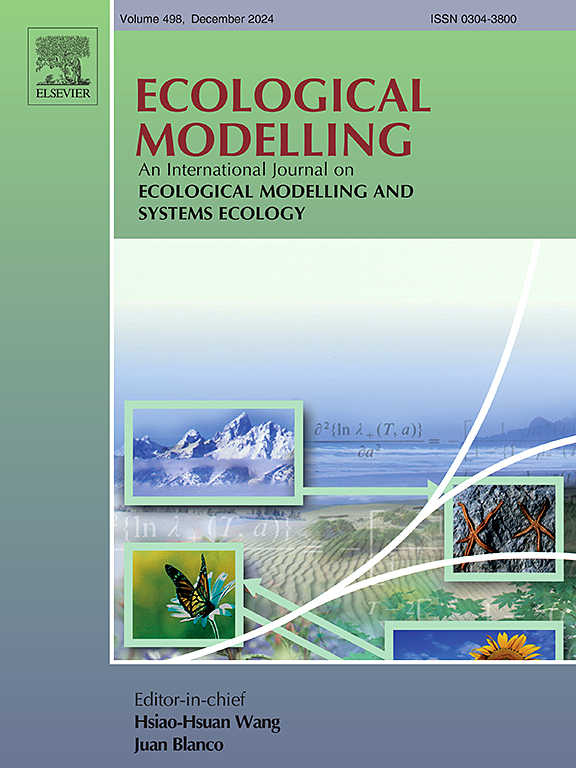Comparing commonly used aquatic habitat modeling methods for native fish
IF 2.6
3区 环境科学与生态学
Q2 ECOLOGY
引用次数: 0
Abstract
Aquatic habitat suitability models are increasingly coupled with water management models to estimate environmental effects of water management. Many types of habitat models exist, but there are no standard methods to compare predictive performance of habitat model types for use with water management models. In this study, we compared three common aquatic habitat model types: a hydraulic-habitat model, a habitat threshold model, and a geospatial model. Each of the models predicted native Bonneville Cutthroat Trout distribution in the Bear River Watershed (Utah, Idaho, and Wyoming, USA) at a monthly timestep. We compared the differences in predictive performance among models by validating 1) environmental predictors of the models with field observations from summer 2022, using the coefficient of determination (R²), Nash–Sutcliffe efficiency (NSE) index, and percent bias (PBIAS) and 2) habitat suitability estimates generated by each model with fish presence data and three accuracy metrics developed for this study. Validation of environmental predictors revealed observed conditions were not well represented by any of the three models—a function of either outdated, incorrect, or over-generalized input data. Validation of habitat suitability predictions using Bonneville Cutthroat Trout presence data showed the habitat threshold model most accurately classified fish presence observations in suitable habitat, but suitable habitat was likely overpredicted. While more precise habitat modeling methods may be useful to support generalized habitat estimates for native fish, overall, simple models, like the habitat threshold model, are promising for incorporating ecological objectives into water management models.
比较常用的本地鱼类水生生境建模方法
水生生境适宜性模型越来越多地与水管理模型相结合,以估算水管理对环境的影响。目前存在多种类型的生境模型,但还没有标准方法来比较与水管理模型结合使用的生境模型类型的预测性能。在这项研究中,我们比较了三种常见的水生生境模型类型:水力生境模型、生境阈值模型和地理空间模型。每种模型都能以月为时间单位预测本地邦纳维尔切喉鳟在熊河流域(美国犹他州、爱达荷州和怀俄明州)的分布情况。我们通过以下方法比较了各模型预测性能的差异:1)利用 2022 年夏季的实地观测结果验证模型的环境预测因子,采用的方法包括判定系数(R²)、纳什-苏克里夫效率(NSE)指数和偏差百分比(PBIAS);2)利用鱼类存在数据和为本研究开发的三个精度指标验证各模型生成的栖息地适宜性估计值。对环境预测因子的验证表明,三个模型都不能很好地反映观测到的条件--这是输入数据过时、不正确或过于概括的结果。使用邦纳维尔切喉鳟(Bonneville Cutthroat Trout)出现数据对栖息地适宜性预测进行的验证表明,栖息地阈值模型最准确地将鱼类出现观测结果归类为适宜栖息地,但适宜栖息地很可能被预测过高。虽然更精确的栖息地建模方法可能有助于支持对本地鱼类栖息地的概括性估计,但总体而言,像栖息地阈值模型这样的简单模型在将生态目标纳入水管理模型方面还是很有前景的。
本文章由计算机程序翻译,如有差异,请以英文原文为准。
求助全文
约1分钟内获得全文
求助全文
来源期刊

Ecological Modelling
环境科学-生态学
CiteScore
5.60
自引率
6.50%
发文量
259
审稿时长
69 days
期刊介绍:
The journal is concerned with the use of mathematical models and systems analysis for the description of ecological processes and for the sustainable management of resources. Human activity and well-being are dependent on and integrated with the functioning of ecosystems and the services they provide. We aim to understand these basic ecosystem functions using mathematical and conceptual modelling, systems analysis, thermodynamics, computer simulations, and ecological theory. This leads to a preference for process-based models embedded in theory with explicit causative agents as opposed to strictly statistical or correlative descriptions. These modelling methods can be applied to a wide spectrum of issues ranging from basic ecology to human ecology to socio-ecological systems. The journal welcomes research articles, short communications, review articles, letters to the editor, book reviews, and other communications. The journal also supports the activities of the [International Society of Ecological Modelling (ISEM)](http://www.isemna.org/).
 求助内容:
求助内容: 应助结果提醒方式:
应助结果提醒方式:


